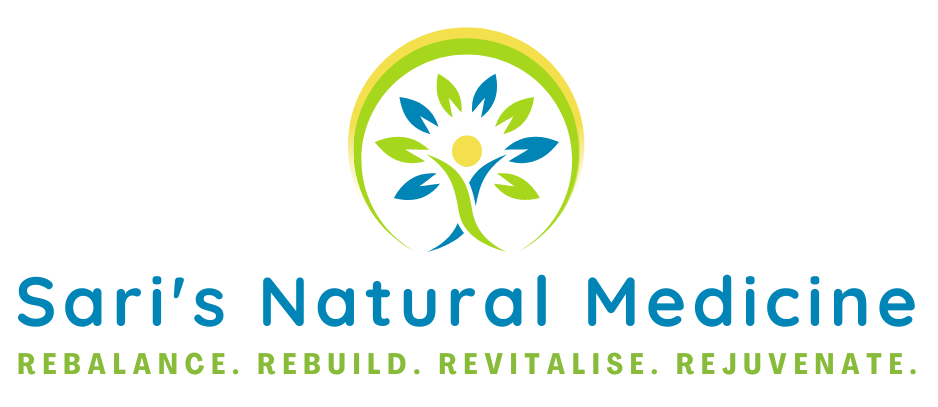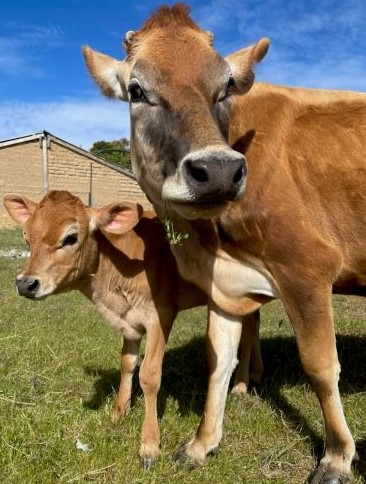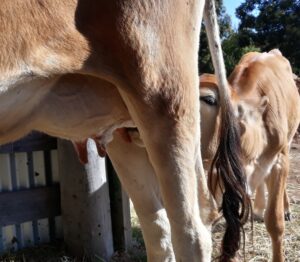Selling raw milk has been illegal for some time in Australia, under the premise that it is dangerous for human health. But is it really unsafe? What does the current science say about this? What are the nutritional differences in raw milk and pasteurised milk?
For years I believed that all dairy was detrimental for human health. It causes so much inflammation and disease, including asthma and eczma. For years I avoided it, and my health was better for it. However, I then came to learn about organic, raw milk. And now I present the case to you.
Raw milk destined for pasteurisation is unsafe
Pasteurisation is the heating process that raw milk undergoes to kill any pathogens that would cause sickness in humans. Raw milk that is “intended for pasteurisation” is generally unsafe to drink. This milk is produced by cows that often have compromised health, live in unsanitary conditions, and are fed hormones (to boost milk production) and antibiotics (to counteract their poor health somewhat).
This type of raw milk contains many pathogens which if consumed raw, would cause illness. It also contains hormone and antibiotic residues. This milk is then pasteurised which kills the pathogens, but it unfortunately also kills all the enzymes, probiotics and significantly decreases the nutrients, proteins and fats available.
Raw milk is safe and highly nutritious
However, raw milk that is not “intended for pasteurisation” is safe as numerous studies have illustrated. Raw milk that is from animals that are healthy because they are carefully looked after, who live in sanitary conditions and where the milk is clean, is not only safe, but highly nutritious.
There any many health benefits to drinking raw milk over pasteurised milk. Pasteurised milk is often cited as one of the top food allergies and is difficult to digest (Frequently asked questions about food allergies. Food and Drug Administration website). In contrast, great quality raw milk is easily digested and in fact prevents food allergies from forming (Loss G et al 2011 The protective effect of farm milk consumption on childhood asthma and atopy: The GABRIELA study. Journal of Allergy and Clinical Immunology 128(4):766-73; House JS et al 2017 Early-life farm exposures and adult asthma and atopy in the Agriculture Lung Health Study. Journal of Allergy and Clinical Immunology 140(1):249-56).
Raw milk contains beneficial living bacteria
The presence of living bacteria which helps produce the lactase enzyme which enables easy digestion means people with lactose intolerance can consume raw dairy just fine! (Sanders SW et al 1992 Effect of a single dose of lactase on symptoms and expired hydrogen after lactose challenge in lactose-intolerant subjects. Clinical Pharmacy 11(6):533-8). The enzymes that help you digest the lactose are denatured, or killed, during the heating process of pasteurisation.
Pasteurising milk reduces the nutrient value significantly
Raw milk includes bioavailable vitamins and minerals, proteins, excellent fats, enzymes and probiotics! However, pasteurisation of milk has a detrimental effect on the nutrient value of the milk. Pasteurised milk has much less nutrients and the fats, proteins, enzymes and probiotics are denatured (rendered useless to the body).
Research shows that pasteurising the milk causes a reduction in calcium and phosphorus bioavailability, decreases copper, iron, Vitamin A, B complex, C and E. It destroys beta-lactoglobulin which decreases intestinal absorption of Vitamin A and D, it destroys probiotics and inactivates enzymes needed for the body to digest the milk.
(Kramer, MM et al. 1928 Dept of Food Economics and Nutrition. A comparison of raw, pasteurised, evaporated, and dried milks as sources of calcium and phosphorus for the human subject; Zurera-Cosano G et al 1994 Effect of processing on contents and relationships of mineral elements of milk. Food Chemistry. 51(1):75-8; Raw Milk Questions and Answers. 2019 USA CDC Nov 6; Panfili G et al. 1998 Influence of thermal and other manufacturing stresses on retinol isomerization in milk and dairy products. Journal of Dairy Research 65(2):253-60; Macdonald LE et al 2011 A systemic review and meta-analysis of the effects of pasteurization on milk vitamins, and evidence for raw milk consumption and other health-related outcomes. Journal of Food Protection. 74(11):1814-32; Said HM et al 1989 Intestinal uptake of retinol: enhancement of bovine milk beta-lactoglobulin. American Journal of Clinical Nutrition. 49(4):690-4; Yang, MC et al 2009 Evidence for beta-lactoglobulin involvement in vitamin D transport in viva- role of the gamma0turn of beta-lactoglobulin in vitamin D binding. FEBS Journal. 276(8):2251-65; Harvard Men’s Health Watch 2018 The growing role of probiotics; Dairy Foods Science Notes 2007 Alkaline Phosphatase testing for milk pasteurization. Cornell University).
Ever wondered why synthetic vitamins are added back into milk after it’s been pasteurized? Now you know why. But remember that synthetic vitamins are NOT the same as the real deal.
Raw milk contains an abundance of nutrients and probiotics
In direct contrast, raw milk has a large amount of important nutrients, enzymes, vitamins, minerals which are usable by the body, and it is easily digestible. It is a great source of calcium, iron, Vitamin A, D, K, phosphorus, zinc, CLA and omega 3 fatty acids, not to mention the many beneficial probiotics and enzymes (Heckman 2015 The role of trees and pastures in organic agriculture. Sustainable Agriculture Research 4:47-55.)
There are many different types and large amounts of probiotics in raw milk (Quigley L et al 2013 The complex microbiota of raw milk. FEMS Microbiology Review 37(5):664-98. These nutrients benefit the gastrointestinal system and the immune system.
Chronic disease used to be treated with raw milk
Raw milk used to be used in hospitals to treat many chronic diseases such as CVD, renal disease liver disease, hypertension, edema, asthma, arthritis, TB and diabetes (Proceedings of the 29th Annual Meeting of the US Livestock Sanitary Association 1925 Use of Milk in the Treatment of Human Disease)!
The benefits of consuming raw milk on health
Many large European studies comparing pasteurised and raw milk, have shown the following benefits:
- significantly lower rates of allergies and asthma
- protection against childhood asthma and eczema
- significantly less childhood asthma, rhino-conjunctivitis, sensitization to pollen, and food allergens, atopy, respiratory infections
- better lung function in adulthood
(Loss G et al 2011 The protective effect of farm milk consumption on childhood asthma and atopy: The GABRIELA study. Journal of Allergy and Clinical Immunology 128(4):766-73; Brick T et al 2016 omega-3 fatty acids contribute to the asthma-protective effect of unprocessed cow’s milk. Journal of Allergy and Clinical Immunology 137(6):1699-1706; Waser, M et al 2007 Inverse association of farm milk consumption with asthma and allergy in rural and suburban populations across Europe. Clinical and Experimental Allergy 37(5):661-70; House JS et al 2017 Early-life farm exposures and adult asthma and atopy in the Agriculture Lung Health Study. Journal of Allergy and Clinical Immunology 140(1):249-56; Wyss AB et al 2018 Raw milk consumption and other early-life farm exposures and adult pulmonary function in the agricultural lung health study. Thorax. 73(3):279-82; Loss G et al 2015 Consumption of unprocessed cow’s milk protects infants from common respiratory infections. Journal of Allergy and Clinical Immunology 135(1):56-62).
Safety of pasteurised and raw milk
Of course, no food is completely safe. In the USA, CDC data shows since 1972 there were 82 deaths from pasteurised dairy! In the USA, the CDC data does not differentiate between raw milk intended for pasteurisation from raw milk that is carefully prepared. The data collected is from raw milk destined for pasteurisation and up to 24% testing positive for pathogens (CDC Surveillance for foodborne disease outbreaks- US 2009-2015). As stated earlier, milk destined for pasteurisation that is raw is unsafe to drink. Even so, there have only been 2 deaths since 1972 and both of these deaths were from queso fresco (which is “bathtub cheese” made illegally at home, and is known to be much more dangerous than raw milk) (CDC Population Survey Atlas of Exposures 2006-2007). Nearly 10 million US citizens consume raw milk as of 2007. Without including queso fresco, from 2000-2007, there was a “roughly 1 in 94,000 chance of becoming ill from drinking unpasteurised milk”. There were 12 hospitalisations, which is an average of 1.5 per year. You have about a 1 in 6 million chance of being hospitalised due to drinking raw milk! (Raw milk reality: is raw milk dangerous? 2019 Kresser C http://chriskresser.com/raw/-milk.-reality-is-raw-milk-dangerous/). Since then, improvements in raw milk production have been made including rigorous testing, with a significant reduction in illnesses related to raw milk.
Conclusion
In conclusion, raw diary from animals that are well looked after, who live in sanitary conditions, who are free from disease, and who are fed on organic pastures, produce milk that is not only safe, but also an incredible source of vitamins, minerals, enzymes, fats, proteins and probiotics. I used to believe dairy was detrimental for human health. It is true that pasterurised non-organic dairy is indeed terrible for your health, but it is NOT the same as organic raw milk intended for human consumption RAW. Consume it raw, just as it was designed, in a safe manner. Clearly the evidence shows that children and adults alike are better for including it in their diet.
I hope you can get your hands on some raw dairy to include it in your daily diet.
Please leave a comment below and get the discussion going!
Acknowledgements: Raw Milk Institute Board of Directors RawMilkInstitute.org. 2019




How enlightening! Thanks for sharing the science highlighting the healthy benefits of natural living. I’m encouraged to know I can help my kids with preventative health strategies such as raw milk that can make so much of a difference. You never cease to amaze me Sari with your knowledge.
Hi Mary, thank for your kind comment. I am delighted to hear that the information I am providing is helping you and your kids improve your health and lives. Improving lives is my mission, and if there is anything else I can provide you, please ask.